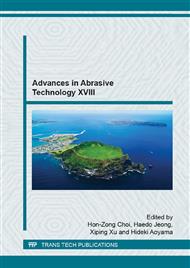p.327
p.333
p.338
p.343
p.350
p.359
p.365
p.371
p.377
Study on Precision Slicing Process of Single-Crystal Silicon by Using Dicing Wire Saw
Abstract:
Precision slicing tests were performed for single-crystal silicon by using a newly developed dicing wire saw system and diamond wires. The developed dicing wire saw enables slicing thick workpiece of hard and brittle materials which could not be sliced by conventional dicing machines. To achieve high precision and efficiency, the dicing wire saw system adopted tension control and high speed control technologies which provides a maximum wire feeding speed of 2000m/min. In this study, the diamond wire was driven in a single direction at a speed of 750-1750m/min and the slicing force, wire wear and workpiece surface roughness after slicing were investigated experimentally. The results showed that as a new slicing system, the developed dicing wire saw was useable for high-precision slicing of thick workpiece.
Info:
Periodical:
Pages:
350-356
Citation:
Online since:
January 2016
Authors:
Price:
Сopyright:
© 2016 Trans Tech Publications Ltd. All Rights Reserved
Share:
Citation:


